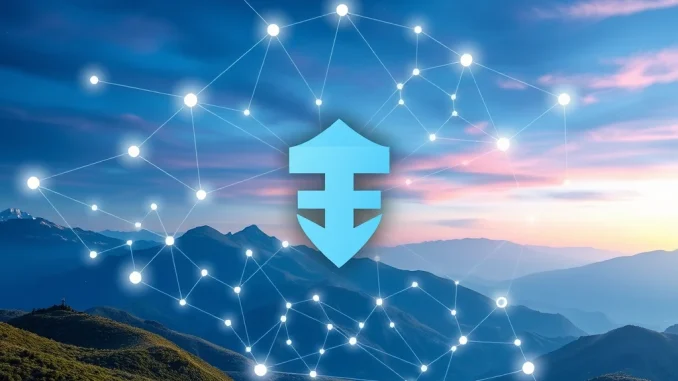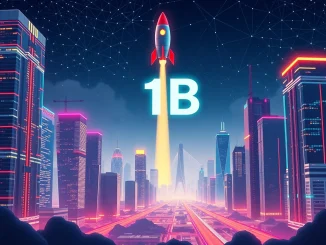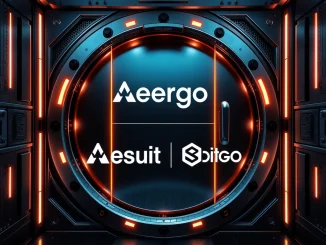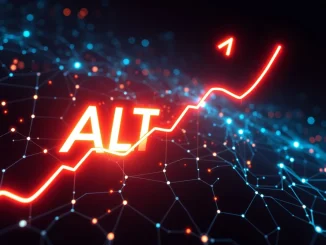
Get ready for a significant move in the crypto space! Tether, widely known for its USDT stablecoin, is stepping into the artificial intelligence arena. The announcement of **Tether AI** signals a bold new direction, aiming to merge the principles of decentralization with the power of AI.
What Exactly is the Tether AI Runtime?
Tether CEO Paolo Ardoino recently shared the exciting news on X. Tether is preparing to launch **Tether.ai**, described as an **open source AI** runtime. Think of a runtime as the environment where software, in this case, AI models, actually run and execute instructions. What makes Tether.ai stand out is its core design philosophy: it’s built to operate on *any* device. This means it won’t rely on giant, centralized servers or require proprietary API keys to function.
Here’s a quick breakdown of what this means:
- Open Source: The code will be publicly available. This fosters transparency, allows community contributions, and can potentially enhance security through collaborative review.
- AI Runtime: It’s the engine that powers AI applications, enabling them to run locally or on various devices.
- Device Agnostic: Designed to work across different hardware, from powerful computers to potentially smaller devices.
- Decentralized Operation: No dependence on single, centralized points of control like specific company servers or mandatory API access.
Why is Tether Pursuing Decentralized AI?
Tether’s venture into **decentralized AI** might seem unexpected for a stablecoin issuer, but it aligns with the broader trend of technological convergence and the ethos of decentralization inherent in blockchain. The current AI landscape is heavily dominated by a few large players, relying on massive data centers and proprietary systems. This centralization raises concerns about data privacy, censorship, control, and accessibility.
By building an **AI runtime** that is open and decentralized, Tether appears to be aiming to:
- Offer an alternative to centralized AI infrastructure.
- Empower developers and users with more control over their AI applications and data.
- Potentially integrate AI capabilities directly with blockchain technology and decentralized applications (dApps).
- Diversify its technological footprint beyond stablecoins.
This move could pave the way for innovative **crypto AI** applications that leverage the strengths of both fields – the trust and transparency of blockchain with the intelligence and processing power of AI.
Potential Benefits and Opportunities
The launch of an **open source AI** runtime by a major crypto entity like Tether presents several potential benefits:
- Increased Accessibility: Lowering the barrier to entry for developers and researchers who might not have access to expensive centralized cloud AI services.
- Enhanced Privacy and Security: Running AI models locally or in a decentralized manner can reduce the need to send sensitive data to third-party servers.
- Censorship Resistance: A decentralized runtime is less susceptible to single points of failure or control by any one entity.
- Innovation Boost: Providing an open platform can spur community-driven development and novel use cases, particularly at the intersection of AI and Web3.
- Edge AI Capabilities: Enabling AI processing closer to the data source on various devices.
Imagine AI-powered dApps that perform complex tasks without relying on centralized cloud AI APIs, or personal devices running sophisticated AI models trained and validated on a decentralized network. The possibilities with **Tether AI** are intriguing.
Challenges on the Horizon
While the concept of **decentralized AI** is promising, building and achieving widespread adoption for an **AI runtime** of this nature comes with challenges:
| Challenge | Description |
|---|---|
| Performance | Ensuring the runtime is efficient and performant across diverse hardware compared to highly optimized centralized systems. |
| Adoption | Convincing developers and users to switch from established centralized AI platforms. |
| Complexity | Managing updates, security, and compatibility in a decentralized, open-source environment can be complex. |
| Resource Requirements | While aiming for ‘any device’, sophisticated AI tasks still require significant computational resources. |
Overcoming these hurdles will be crucial for Tether.ai’s success in competing with existing centralized AI offerings.
The Convergence of Crypto and AI
Tether’s move highlights a growing trend: the convergence of crypto and AI. Both fields are at the forefront of technological innovation, and their combination can unlock powerful new applications. **Crypto AI** can manifest in various forms, from AI-powered trading bots and fraud detection on blockchains to decentralized marketplaces for AI models and data, or even using AI to optimize blockchain networks themselves. Tether.ai positions itself as a foundational piece of infrastructure for this evolving landscape.
What’s Next for Tether.ai?
As an **open source AI** project, the next steps likely involve releasing the code, building a developer community, and iterating based on feedback and contributions. The success will heavily depend on the quality of the runtime, the ease of use for developers, and the community’s willingness to contribute and build applications on it. Keep an eye on Paolo Ardoino’s announcements and Tether’s official channels for updates on the rollout and how to get involved.
A Bold Step into the Future
Tether’s decision to launch an **AI runtime** is a significant development. By focusing on an **open source AI** model that is **decentralized AI** by design, Tether is challenging the status quo in the AI industry and building bridges between the crypto and AI worlds. While challenges exist, the potential for innovation and empowering users with more control over their AI interactions through **Tether AI** is immense. This move underscores Tether’s ambition to be more than just a stablecoin provider, positioning itself as a key infrastructure builder for the future of decentralized technology and artificial intelligence.



